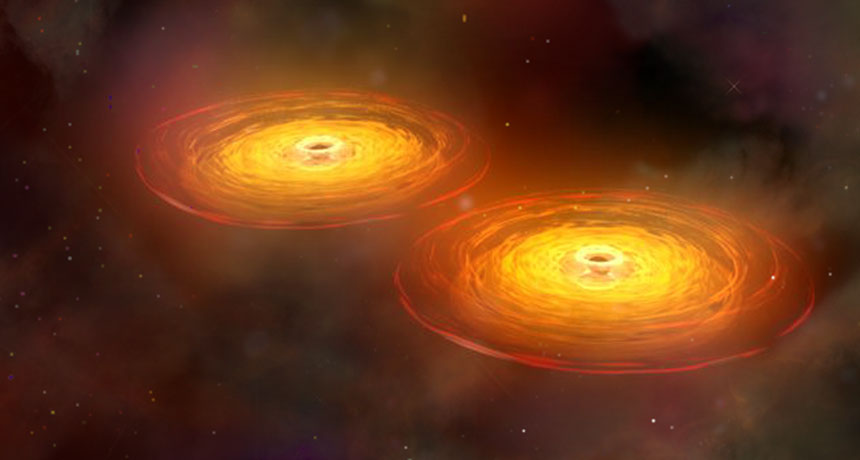Black holes are on collision course
The distant smashup won’t happen for a million years

This image, made from a computer simulation, shows two supermassive black holes. They appear poised to collide at the center of galaxy PG 1302-102.
NASA/CXC/A. HOBART, JOSH BARNES (U. OF HAWAII), JOHN HIBBARD (NRAO)
SEATTLE — Black holes are regions of space where the gravitational field is so intense that no matter nor light can escape. In the center of a distant galaxy — a massive collection of stars — two supermassive black holes are now preparing to face off. The two are closer to each other than any other known black-hole duo. And they are providing astronomers a first peek at the final stages of a possible collision.
The two black holes live roughly 3.7 billion light-years away. Their home is a quasar, the ferociously bright core of a galaxy. It is lit up by superheated gas spiraling onto a supermassive black hole. A quasar’s brightness typically varies randomly. But for the last two decades, light from this quasar — known as PG 1302-102 — has not. It has varied with a steady, repeating manner.
That suggests that this quasar hosts two black holes, working together, says George Djorgovski. An astronomer at the California Institute of Technology, in Pasadena, he described the galactic drama on January 7 here at a meeting of the American Astronomical Society. His team’s research also appears online in the January 7 issue of Nature.
A distance of just a few hundredths of a light-year separates the black holes. So they seem destined to spiral together and eventually merge. This smashup will likely result in a single, behemoth black hole. But don’t hold your breath awaiting the fireworks. This collision is still roughly 1 million years off.
Theories of galaxy formation predict that close black-hole pairs should be relatively common. They would arise when two galaxies collide. But because galaxies are so far away — except for our home (the Milky Way) — hunting down such binary black holes has proven a challenge.
Power Words
astronomy The area of science that deals with celestial objects, space and the physical universe as a whole. People who work in this field are called astronomers.
binary Something having two integral parts.
black hole A region of space having a gravitational field so intense that no matter nor radiation (including light) can escape.
galaxy A massive group of stars bound together by gravity. Galaxies, which each typically include between 10 million and 100 trillion stars, also include clouds of gas, dust and the remnants of exploded stars.
light-year The distance light travels in one year, about 9.48 trillion kilometers (almost 6 trillion miles). To get some idea of this length, imagine a rope long enough to wrap around the Earth. It would be a little over 40,000 kilometers (24,900 miles) long. Lay it out straight. Now lay another 236 million more that are the same length, end-to-end, right after the first. The total distance they now span would equal one light-year.
Milky Way The galaxy in which Earth’s solar system resides.
quasar Short for quasi-stellar light source. This is the brilliant core of some galaxy (massive collections of stars) that contains a super-massive black hole. As mass from the galaxy is pulled into that black hole, a huge quantity of energy is released, giving the quasar its light.
random Something that occurs haphazardly or without reason, based on no intention or purpose.







